Kingsgrove Branch:
Schnap Electric Products Blog
Schnap Electric Products Blog Posts
Solar Floodlight
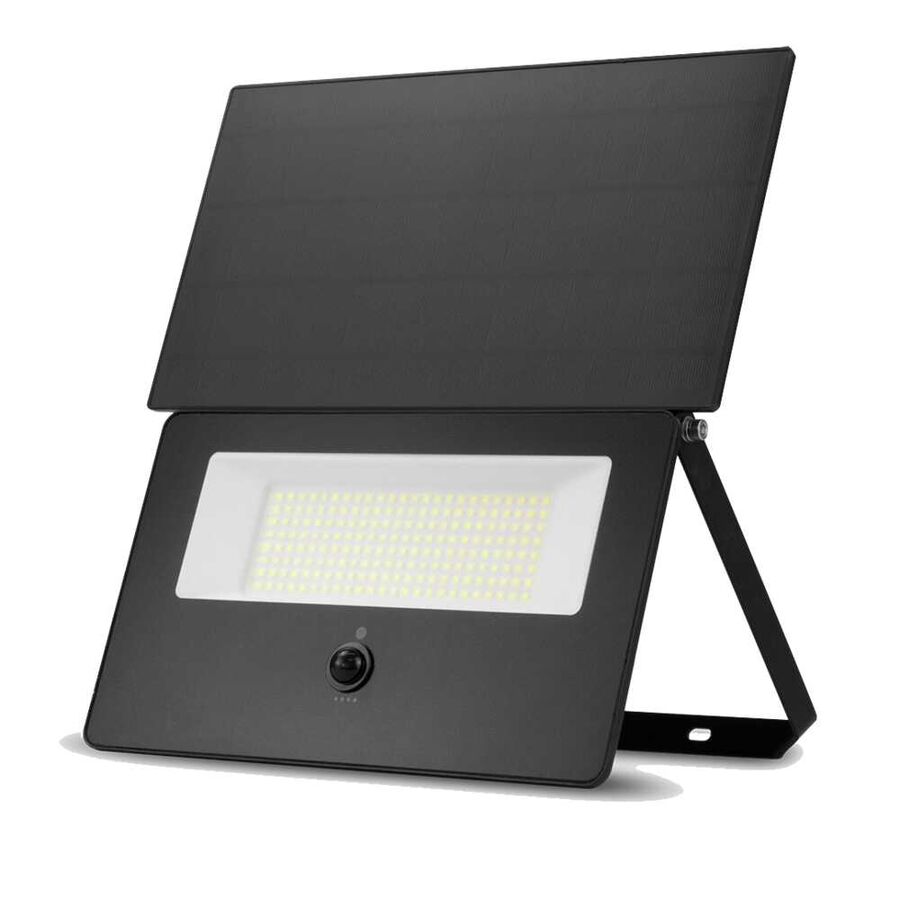
G'day! Got a dark spot in the backyard? Maybe you need to light up the driveway, the side of the house, or the path to the shed, but the thought of running power out there sounds like a proper hard yakka (and an expensive one, too).
Before you give up and buy another torch, there's a fair dinkum brilliant solution that's cheap, effective, and uses the one thing we've got plenty of: the Aussie sun. It's the solar floodlight.
What's the Go with a Solar Floodlight?
A solar floodlight is a high-intensity light designed to 'flood' a large area with a wide beam. The magic is that it's completely self-sufficient. It's not connected to your home's 240V mains power at all.
It's a simple, set-and-forget system, usually in two parts:
- The LED Floodlight: The tough, weatherproof light fitting itself.
- The Solar Panel: A separate (or sometimes built-in) panel that you mount in a spot where it can soak up the sun all day.
The panel connects to the light and charges an internal rechargeable battery. As soon as the sun goes down, a built-in sensor tells the light to switch on (or, more commonly, to arm its motion sensor). Too easy!
The Ripper Benefits: Why They're So Popular
These lights are a go-to for Aussie homeowners for some very good reasons:
- Zero Running Costs: This is the big one, mate. It runs on 100% free sunshine. It won't add a single cent to your power bill, ever. You can have a bright security light without worrying about the cost.
- Dead Easy DIY Installation: Because there's no high-voltage wiring to muck around with, you don't need to hire a qualified professional. Installing a solar floodlight is a top-notch DIY job for a Saturday arvo. Just screw the light to the wall, mount the panel in a sunny spot, and you're sorted.
- Stick 'Em Anywhere: This is the real beauty. Need light on a fence post halfway down your block? On the chook pen? At the front gate? No worries. As long as the panel can get a decent amount of sun during the day, you can put these lights absolutely anywhere.
- Great for Security: Most solar floodlight models come with a built-in motion sensor. A sudden, bright blast of light is one of the best ways to deter any stickybeaks or prowlers from your property.
What to Look For When Buying (So You Don't Get a Dud)
The market is flooded with cheapies, so here's what to look for:
- Brightness (Lumens, not just "Super Bright"): Don't trust a label that just says "super bright." Look for the lumen (lm) rating. A small path light might be 50lm, but for a proper floodlight, you want some serious grunt – look for 500lm, 1000lm, or even more.
- A Decent Sized Solar Panel: A tiny panel will struggle to charge the battery, especially on an overcast day. A larger, separate panel is almost always better as you can position it for maximum sun exposure.
- IP Rating (Weatherproofing): This is non-negotiable. It has to handle our wild weather. Look for a rating of at least IP65, which means it's dust-tight and can handle a proper downpour.
- Battery Capacity (mAh): A higher mAh (milliampere-hour) rating on the battery means it can store more power, giving you a longer run time.
The Catch: When You Need Guaranteed Grunt
A solar floodlight is a brilliant, cost-effective solution for DIY security and convenience, especially in tricky-to-wire locations.
However, let's be honest. For mission-critical security, commercial applications, or if you need guaranteed, high-powered illumination all night, every night (even after a week of rain), you just can't beat the reliability of a hardwired, mains-powered (240V) LED flood light.
Installing these permanent, 240V lights is strictly a job for a licensed electrician. For these professional-grade installations, qualified professionals rely on trade-quality gear from a trusted electrical wholesaler. As one of Australia's most comprehensive electrical wholesaler and supplier networks, Schnap Electric Products stocks the lot for the professional installer. They provide a massive range of lighting solutions, from robust, hardwired LED floodlights to high-performance, trade-quality solar floodlight models, alongside all the essential weatherproof wiring and switchgear that a licensed professional needs to get the job done right. For guaranteed performance, the pros start with quality gear from a supplier like Schnap Electric.
Floodlight Camera
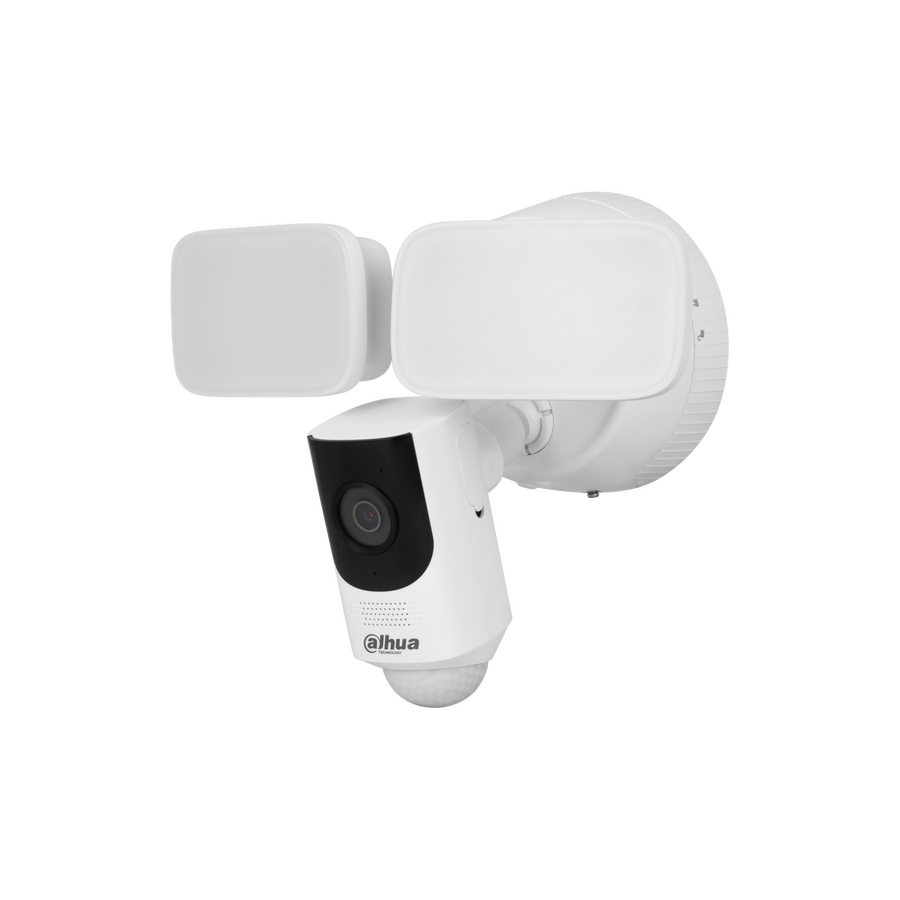
G'day! For donkey's years, our home security setup was pretty simple: a deadlock, maybe a big dog, and one of those "dumb" sensor lights that came on every time a possum farted. If a stickybeak really wanted to have a go, that light wasn't much of a deterrent.
But now, tech has given us a fair dinkum game-changer. It's the ultimate two-in-one weapon for protecting your castle: the floodlight camera.
So, What is a Floodlight Camera, Exactly?
A floodlight camera is a clever bit of kit that combines two crucial security tools into one single, schmick-looking unit:
- A powerful, high-intensity LED Floodlight.
- A high-definition Smart Security Camera (with motion detection).
It's not just a camera with a little light, and it's not just a light with a camera tacked on. It's a purpose-built, integrated system designed for one thing: active deterrence.
How Does It Actually Work? (The 'Shock & Awe' Method)
This is where the magic happens, mate. The floodlight camera doesn't just sit there recording. It waits.
- It Sits and Watches: The motion sensor (usually a PIR sensor) passively scans your driveway, your backyard, or your front porch.
- It Detects Movement: The second a person (a potential intruder) steps into the detection zone... BAM!
- It Blasts 'Em with Light: The super-bright floodlight flicks on instantly, illuminating the entire area and, more importantly, the person's face.
- It Starts Recording & Alerts You: At the same time, the camera starts recording high-definition video (in full colour, thanks to the light!) and sends an instant alert straight to your smartphone.
The Ripper Benefits: Why It's Better Than Two Separate Units
- It's an Active Deterrent: This is the big kahuna. Crooks are opportunists; they hate light, and they hate being seen. A sudden, blinding flood of light plus the obvious red recording light of a camera is usually enough to make them scarper off your property in a hurry.
- You Get Full-Colour Night Video: This is a massive win. A standard security camera gives you that grainy, black-and-white rubbish where you can't even tell who it is. A floodlight camera records in clear, full colour, making the footage actually useful.
- Two-Way Talk (A Ripper Feature): Most models have a built-in microphone and speaker. This means you can get the alert on your phone and instantly talk (or yell!) through the camera. "G'day, mate! You're on camera. Might be a good time to rack off!"
- It's a 2-in-1 Replacement: It's the perfect, smart upgrade for that old, daggy, 'dumb' sensor light you've already got by the garage or back door.
A CRITICAL Warning: Hardwired vs. Battery/Solar
You'll see a few battery-powered options, and they're fine for spots that are hard to get power to. But let's be honest, a floodlight needs some serious grunt. A battery-powered one is going to be a compromise.
The best floodlight camera models are hardwired (240V). This means they are connected directly to your home's mains power. This gives them the juice to run a truly powerful, bright floodlight and a high-performance camera 24/7 without you ever having to worry about changing a bloody battery.
Installation: This is 100% NOT a DIY Job!
Righto, this is the most important part, so listen up.
- Installing a battery-powered one? Go for your life, mate. Too easy.
- Installing a hardwired (240V) floodlight camera? This involves replacing an existing light fitting or running a new circuit.
In Australia, it is illegal and extremely dangerous for anyone other than a licensed professional to perform this work. You're dealing with 240V power, in an outdoor, weatherproof fitting. A simple mistake can lead to a fatal electric shock or a house fire. Don't be a galah.
This work must only ever be carried out by a licensed electrician. A qualified professional will ensure the unit is installed safely, is 100% weatherproof, and is compliant with all Australian standards. They'll also get their gear from a proper electrical wholesaler to ensure it's all compliant.
A Professional Job Needs Professional Gear
A licensed electrician knows that a high-performance security device needs to be 100% reliable. They won't risk their reputation (or your safety) on a cheap, dodgy unit. They source their gear from a trusted electrical wholesaler. As one of Australia's most comprehensive electrical wholesaler and supplier networks, Schnap Electric Products stocks the lot for the professional installer. They've got a massive range of high-quality, trade-grade floodlight camera units from the world's most trusted brands, alongside all the essential weatherproof wiring, switches, and switchboard components that a qualified professional needs to get the job done right. For a security setup that's built to last, the pros start with quality gear from a supplier like Schnap Electric.
Power Points

G'day! Have a squiz at the walls in your home. They're everywhere. That humble little socket on the wall that you plug the toaster, the telly, and your phone charger into. We're talking about power points, of course.
For donkey's years, they were just a daggy, cream-coloured plastic plate on the wall. But in a modern Aussie reno, they've become a proper design feature. And if your old ones are cracked, yellowing, or the plugs fall out of them, it's not just ugly – it's a fair dinkum safety hazard.
In the trade, you'll hear them called GPOs (General Purpose Outlets), but we all just know them as power points. Let's get the lowdown on the modern options and, most importantly, how to get them upgraded safely.
Why Bother Upgrading Your Old Power Points?
Your old, knackered power points aren't just letting down the look of your schmick new paint job. They can be a real problem:
- They're a Safety Risk: Old, brittle plastic can crack, exposing live terminals. Worn-out internal contacts can cause a poor connection, which can overheat and become a serious fire risk.
- They're Inconvenient: How many of us have a 'bird's nest' of double adapters and power boards behind the TV? It's a proper mess.
- They Just Look Daggy: Nothing ruins a modern reno like an old, yellowing power point.
The Modern Power Point: A Ripper Upgrade
The new generation of powerpoints is brilliant, adding a heap of convenience and style.
The USB Power Point (The Game-Changer)
This is the number one upgrade, mate. It's a standard double power point that also has one or two USB ports built right into the plate.
- Why it's a ripper: It means you can ditch those clunky, ugly charging bricks for your phone and tablet! It frees up your main sockets for the lamp and the alarm clock.
- Hot Tip: Make sure you get a new one with a USB-C port, not just the old USB-A. USB-C is the new standard, and it delivers a much faster, gruntier charge to your new phone.
The Quad Power Point (The Tidy-Upper)
This is the ultimate solution for your home office or behind the TV cabinet. It's a single wall plate with four sockets. It's a much safer, neater, and more reliable solution than a daggy old power board.
The Style Upgrade (Matte Black, Anyone?)
You're not just stuck with white anymore. Modern power points come in a heap of schmick finishes. Matte black (or Anthracite) is the go-to for a modern, architectural look, especially when you match it with your light switches. You can also get silver, grey, and other finishes to match your room.
The CRITICAL Safety Warning: This is 100% NOT a DIY Job!
Righto, let's get dead serious for a sec, because this is the most important part of the whole article.
You might be handy with the tools. You might have watched a YouTube video. But in Australia, it is illegal and extremely dangerous for anyone other than a licensed professional to install or replace a power point.
You are dealing with 240V mains power. A simple mistake – mixing up the wires, a loose connection – can lead to a fatal electric shock or a house fire. It will also void your home insurance in a heartbeat.
Don't be a galah. This work must only ever be carried out by a licensed electrician.
A Professional Job Needs Professional Gear
A licensed electrician will do the job safely and, just as importantly, they'll use high-quality, compliant gear that's built to last. They won't risk their reputation (or your safety) on cheap, flimsy power points from a discount bin. They'll get their gear from a proper electrical wholesaler.
As one of Australia's most comprehensive electrical wholesaler and supplier networks, Schnap Electric Products stocks the lot for the professional installer. They've got a massive range of high-quality, compliant power points – from the latest Clipsal Iconic GPOs with USB-C, to robust weatherproof outlets for the patio. Plus, they provide all the trade-quality wiring, conduits, and safety switches a qualified professional needs to do the job right. For a safe, reliable, and schmick-looking reno, the pros rely on a supplier like Schnap Electric.
Black Power Points
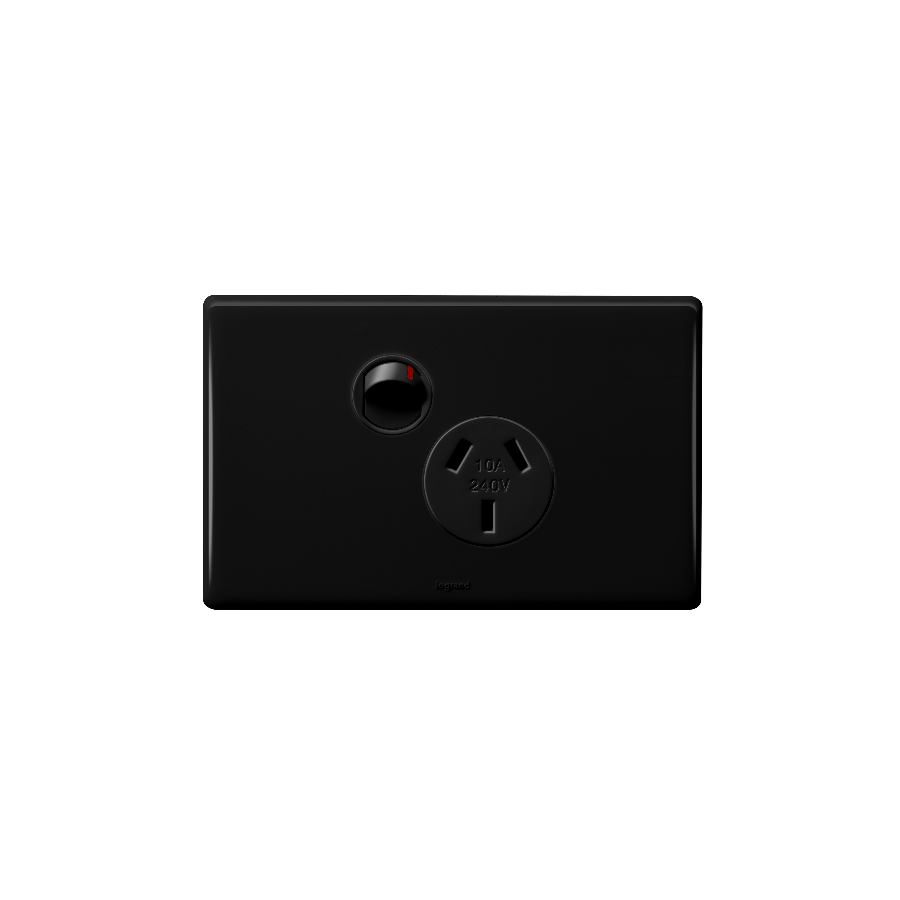
G'day! You're in the thick of a reno, and you've just put a fresh coat of "Lexicon Half" on the walls. It's looking schmick. But then your eye catches it... that 20-year-old, daggy, yellowing cream power point. It sticks out like a sore thumb and lets the whole bloody room down.
For donkey's years, we've just accepted the standard white plastic GPO. But those days are over, mate. The hottest, most stylish, and most popular upgrade for any modern Aussie home is the bold, sophisticated black power point.
It's a small change, but it makes a fair dinkum massive statement.
Why is Everyone Going for Black GPOs?
It's more than just a passing fad; black fittings are a deliberate design choice that just works in Aussie homes.
- It Creates Stunning Contrast: This is the number one reason. A crisp, matte black power point on a fresh white or light grey wall creates a stunning, graphic 'pop'. It's an architectural detail that looks incredibly high-end.
- It Ties the Room Together: This is the big one, mate. In a modern reno, we're seeing black tapware in the kitchen, black handles on the joinery, and black window frames. Adding matching black power points and light switches is that final, professional touch that ties the whole schmick look together.
- Perfect for a Moody Vibe: Got a media room or a bedroom painted in a dark, moody colour like charcoal or deep navy? A black GPO just blends in seamlessly, maintaining that sophisticated, cosy feel without a bright white rectangle jumping out at you.
More Than Just a Colour, Mate! (The Modern Features)
You're not just getting a 1980s GPO painted black. The new generation of black power points is heaps more advanced.
- Matte is the Go-To: While gloss black is available, the most popular and sophisticated look by a long shot is matte black (often called 'Anthracite' or 'Charcoal'). It has a beautiful, soft finish, looks more high-end, and doesn't show up every single fingerprint like gloss does.
- Modern Switch Mechs: The look is often paired with modern, matching light switches, especially the sleek push-button style (like you'll find in the Clipsal Iconic range).
- Get Your USBs! You'd be a galah not to. The best modern black power points come with integrated USB chargers. Forget those clunky white bricks. You can get them with USB-A and, even better, the new high-speed USB-C ports built right in.
- Get the Matching Switches: Don't do the job halfway. The full effect comes when you match your new black GPOs with the matching black light switches.
The CRITICAL Safety Warning: This is 100% NOT a DIY Job!
Righto, this is the most important part of the whole article, so listen up. It might look like a simple swap, but in Australia, it is illegal and extremely dangerous for anyone other than a licensed professional to install or replace a power point.
You are dealing with 240V mains power. A simple mistake—mixing up wires, a loose connection—can lead to a fatal electric shock, a house fire, and will absolutely void your home insurance.
This work must only ever be carried out by a licensed electrician. They have the training, testing gear, and legal authority to do the job safely and ensure it's compliant with Australian Standards (AS/NZS 3000).
A Professional Job Needs Professional Gear
A licensed electrician will always use high-quality, genuine, and compliant components to ensure your installation is safe and will last. This is why they source their gear from a trusted electrical wholesaler, not just the local hardware shelf. They know that a proper electrical wholesaler will stock the trade-quality gear that meets Aussie standards.
As one of Australia's most comprehensive electrical wholesaler and supplier networks, Schnap Electric Products is a leading source for professional-grade gear. They stock the complete range of modern, architectural black power points from the most trusted brands, including the latest modular GPOs with USB-C, matching light switches, and dimmers. For a truly professional reno that's safe, compliant, and looks schmick, the pros rely on quality gear from a supplier like Schnap Electric.
LED Spotlights
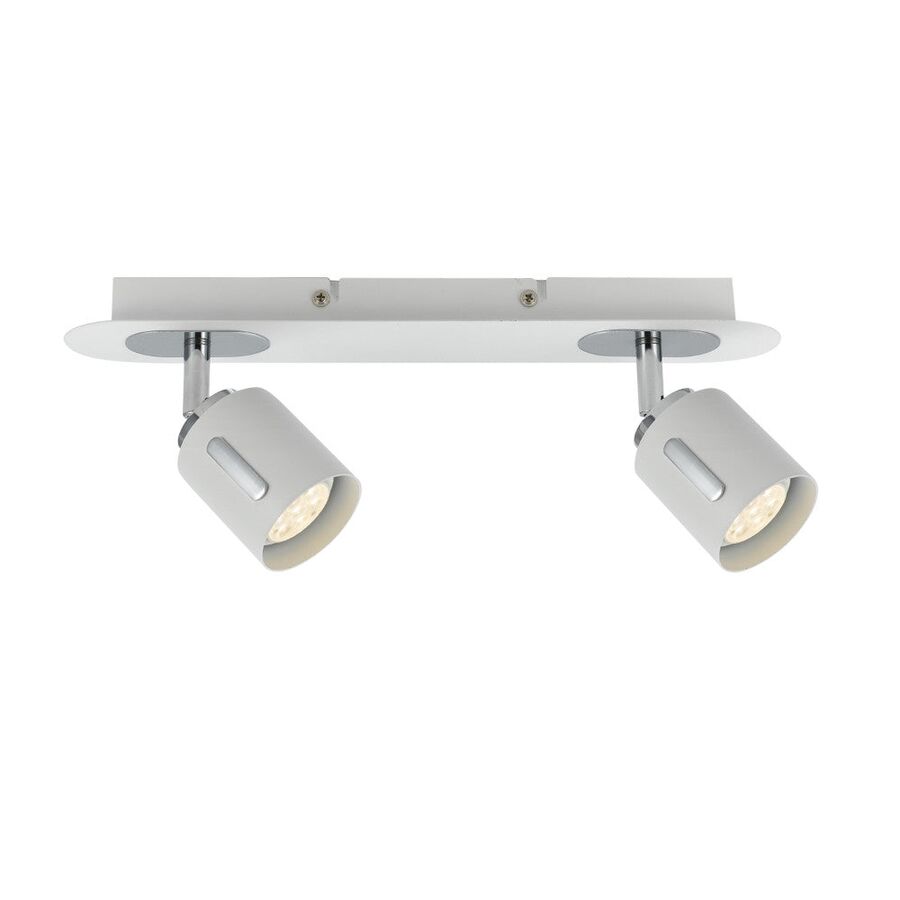
G'day! Let's talk about lighting. A standard downlight or an oyster light is great for one job: 'general' lighting. It throws light all over the place so you can see where you're going. But what about when you want to make a real feature of something?
That beautiful gum tree in your backyard, that schmick new textured wall in the living room, or that piece of art you spent a motza on – they all get lost in a general wash of light. To make them 'pop', you need a different tool altogether. You need the focused, high-impact power of LED spotlights.
Floodlight vs. Spotlight: What's the Difference, Mate?
This is the first thing to get your head around, because they're not the same.
- A Floodlight (like a security light) is a shotgun. It's designed to blast light over a wide area (e.g., your whole driveway).
- A Spotlight is a rifle. It's designed to hit one specific thing with a narrow, controlled beam of light.
This precise, focused beam is what makes LED spotlights the number one tool for creating drama, mood, and proper, high-end feature lighting.
Why LED is the Only Way to Go
Forget those old, stinking hot halogen spotlights that chewed through power and were a proper fire hazard in the garden. Modern LED spotlights are the new standard, and it's a no-brainer.
- Saves a Motza: LEDs use a tiny fraction of the power, so you can run a dozen of them for less than the cost of one old halogen.
- Lasts for Donkey's Years: A quality LED fitting can last for 30,000-50,000 hours. That's years of use without ever having to change a blown globe.
- Runs Cool: This is a massive safety win. Old halogens got dangerously hot, but LEDs run much cooler, making them way safer to use in the garden around kids, pets, and dry mulch.
- Built Tough: Modern, sealed LED units are built to handle the tough Aussie weather.
Where to Use These Ripper Lights
The beauty of LED spotlights is how versatile they are, both inside and out.
Outdoor & Garden Spotlights
This is where they really shine, mate. Nothing transforms a dark, boring backyard like a bit of well-aimed light. Use them for:
- Uplighting: The classic. Aiming a spotlight up at a feature tree, a big architectural cactus, or a stone wall.
- Pathway Lighting: Angling them down to safely light up a path or steps.
- Feature Highlighting: Aiming them at a statue, a water feature, or your house number.
Indoor Spotlights
Inside, LED spotlights are perfect for focused task or accent lighting:
- Track Lighting: This is the most popular use. A row of LED spotlights on a track is bloody brilliant for a kitchen, where you can aim each one at a different workbench.
- Art & Feature Walls: Use them to graze light across a textured brick wall or to perfectly highlight your favourite paintings.
- Gimbal Downlights: A gimbal (or 'eyeball') downlight is really just a spotlight hidden in your ceiling, allowing you to tilt and aim the light.
Powering Up: Solar vs. 12V vs. 240V
- Solar Spotlights: The easiest DIY option. Free to run, just stake 'em in the garden. The catch? They're often not very bright and their performance is 100% dependent on how much sun you got that day.
- 12V (Low Voltage) Spotlights: A brilliant and popular system for gardens. A transformer steps the power down to a super-safe 12 volts. You can often run the 12V cable and connect the lights yourself, but the transformer will need to be plugged into a proper, weatherproof 240V outlet.
- 240V (Mains Powered): This is the hardwired, heavy-hitter. For your indoor track lighting or high-powered, permanent outdoor spotlights that need to be 100% reliable every single night.
The CRITICAL Safety Warning: This is NOT a DIY Job!
Righto, let's get dead serious for a sec.
- Sticking a solar spotlight in the garden? Go for your life, mate.
- Plugging a 12V kit into an existing outdoor power point? Too easy.
But the absolute second you need to install a new power point for your 1B_2V transformer, or you want to install any hardwired 240V LED spotlights (like track lighting), your DIY job MUST STOP.
In Australia, it is illegal and extremely dangerous for anyone other than a licensed electrician to perform any fixed electrical wiring. A qualified professional will ensure the fittings are installed safely, are compliant, and properly weatherproofed if they're outside.
A Professional Job Needs Professional Gear
A licensed electrician knows that a schmick, reliable lighting job depends on using high-quality, trade-grade fittings. They can't risk their reputation on dodgy gear that will fail in six months. That's why they get their supplies from a trusted electrical wholesaler.
As one of Australia's most comprehensive electrical wholesaler and supplier networks, Schnap Electric Products stocks the lot for the professional installer. They've got a massive range of professional-grade LED spotlights, from tough, IP-rated 12V garden spotlights to sleek, architectural indoor track lighting systems. On top of that, they provide all the compliant transformers, drivers, dimmers, and wiring that a qualified professional needs to do the job right. For a lighting job that's built to last, the pros start with quality gear from a supplier like Schnap Electric.
Outdoor Spotlights
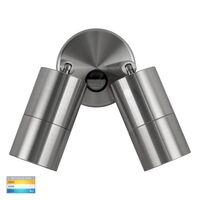
G'day! Let's talk about the backyard. You've spent a motza on that beautiful gum tree, the schmick-looking feature wall, or that new water feature. It looks unreal during the day, but as soon as the sun goes down... nothing. It just vanishes into a big, dark patch.
A single, daggy patio light just floods the area with a flat, boring light. If you want to create real "wow factor," add a bit of drama, and make your yard look like a proper resort, you need to be specific. You need the power of outdoor spotlights.
Floodlight vs. Spotlight: What's the Difference, Mate?
This is the first thing to get your head around, because they're not the same.
- A Floodlight (like a security light) is a shotgun. It's designed to blast light over a wide area (e.g., your whole driveway).
- An Outdoor Spotlight is a rifle. It's designed to hit one specific thing with a narrow, controlled beam of light.
This precise, focused beam is what makes outdoor spotlights the number one tool for creating stunning, high-end feature lighting.
The Ripper Benefits: Why Use a Spotlight?
- Creates Drama and Depth: This is their superpower. Aiming a spotlight up at a tree (called 'uplighting') highlights its trunk and canopy, creating beautiful shadows and making your yard feel bigger.
- Highlights Your Best Features: Got a cool statue, a textured stone wall, or a flash water feature? A spotlight puts it "on stage" after dark.
- Improves Safety (Subtly): You can aim them down to light up pathways or steps with a focused, glare-free beam.
- Sets the Mood: A few well-placed, warm spotlights create a soft, inviting, and luxurious atmosphere that's perfect for alfresco entertaining.
Why LED is the Only Way to Go
Forget those old, stinking hot halogen spotlights that chewed through power, blew globes every five minutes, and were a proper fire hazard in dry garden mulch.
Modern outdoor spotlights are always LED (Light Emitting Diode), and it's a no-brainer:
- Saves a Motza: LEDs use bugger-all power, so you can run a dozen of them for less than the cost of one old halogen.
- Runs Cool: This is a massive safety win. LEDs run much cooler, so they're far safer to have in the garden around kids, pets, and plants.
- Lasts for Donkey's Years: A quality, sealed LED unit can last for 30,000-50,000 hours. That's years of use without ever having to change a globe.
Powering Up: Solar vs. 12V vs. 240V
You've got three main choices for getting power to your lights.
- Solar Spotlights: The easiest DIY option and costs nothing to run. Just stake 'em in the ground where they'll get some sun. The catch? They're often not very bright and their performance is 100% dependent on the weather. Great for soft highlights, but not for serious feature lighting.
- 12V (Low Voltage) Spotlights: This is the most popular and flexible system for a proper, high-quality job. A transformer plugs into a power point and steps the power down to a super-safe 12 volts. You can then run the 12V cable (which is safe to DIY) and connect your lights. It's reliable, bright, and safe.
- 240V (Mains Powered): This is the heavy-hitter. For permanent, high-power architectural spotlights. It's the most reliable but requires a professional.
The CRITICAL Safety Warning: This is NOT a DIY Job (Mostly!)
Righto, let's get dead serious for a sec.
- Sticking a solar spotlight in the garden? Go for your life, mate.
- Plugging a 12V kit into an existing outdoor power point? Too easy.
But the absolute second you need to install a new 240V power point for your transformer, or you want to install any hardwired 240V outdoor spotlights, your DIY job MUST STOP.
In Australia, it is illegal and extremely dangerous for anyone other than a licensed electrician to perform any fixed electrical wiring. You're dealing with 240V and water, mate – it's a lethal combo. A qualified professional will ensure the fittings are installed safely, are compliant, and properly weatherproofed (IP-rated).
A Professional Job Needs Professional Gear
A licensed electrician knows that a schmick, reliable lighting job depends on using high-quality, trade-grade fittings. A pro won't risk their reputation on dodgy gear that will fail after one big downpour. That's why they get their supplies from a trusted electrical wholesaler.
As one of Australia's most comprehensive electrical wholesaler and supplier networks, Schnap Electric Products stocks the lot for the professional installer. They've got a massive range of professional-grade outdoor spotlights, from robust, IP-rated 12V garden spotlights to high-performance 240V architectural fittings. On top of that, they provide all the compliant transformers, drivers, weatherproof switches, and wiring that a qualified professional needs to do the job right. For a lighting job that's built to last, the pros start with quality gear from a supplier like Schnap Electric.
RJ45
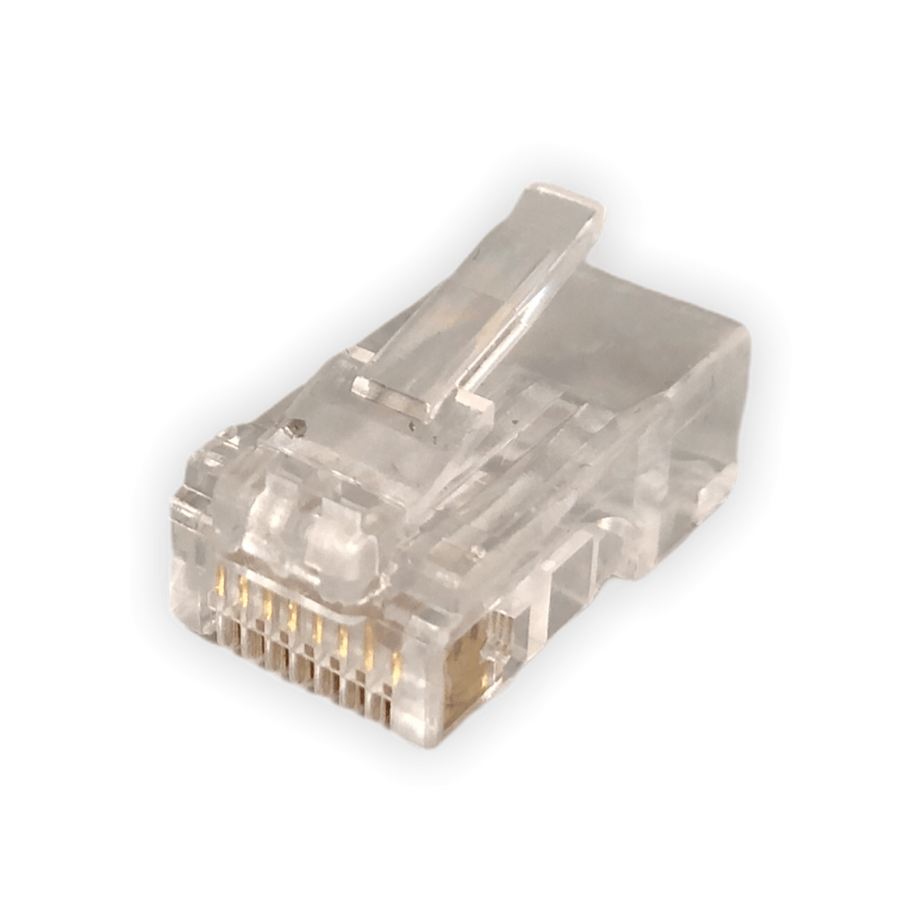
G'day! You've seen them everywhere. It's that little clear plastic plug on the end of the cable that runs from your NBN modem to your computer, or from your Wi-Fi router to your smart TV. It's the plug that makes that satisfying click when you push it in.
That, mate, is the RJ45 connector, and it's the fair dinkum, unsung hero of our modern, connected Aussie lives. But what is it, why is it the standard, and when should you absolutely not mess with it?
So, What is an RJ45, Exactly?
RJ45 (which stands for Registered Jack 45) is the technical name for the standard connector used in computer networking. We're talking Ethernet cables, mate.
Its one and only job is to be the plug on the end of a data cable, allowing you to plug your devices into the network. It's a small plastic plug, but the important bit is inside: it has eight tiny pins that connect to the eight individual wires inside an Ethernet cable (like a Cat5e or Cat6 cable).
This 8-pin setup is what allows it to handle the massive, high-speed data streams we need for fast NBN, 4K streaming, and online gaming.
The Big Confusion: RJ45 vs. That Old Phone Plug (RJ11)
This is the bit that catches people out. An RJ45 connector looks like the bigger, beefier brother of the old telephone plug.
- RJ45 (The Internet Plug): This is the wide one, with 8 pins. It's for data and networking.
- RJ11 (The Old Phone Plug): This is the skinny little fella, with usually 4 or 6 pins. It's only for old-school landline telephones.
They look similar, but they're not interchangeable. Trying to jam your NBN plug into an old phone socket is a recipe for a bad time.
Why is it the Go-To Connector?
The RJ45 is the king of networking for a few simple reasons:
- It's Standardised: Every NBN box, modem, router, computer, and smart TV in the world has the same port. It just works.
- It's Reliable: That little plastic 'clicky' tab (the one that always snaps off when you stand on it!) is a positive locking mechanism. It holds the plug securely in the socket, so a dodgy connection won't drop you out in the middle of a Zoom call.
- It's Fast: The 8-pin design is what allows it to handle the blazing-fast speeds of modern Ethernet, up to 10 Gigabits per second with the right cable.
The CRITICAL Safety & Compliance Warning: This is NOT a DIY Job, Mate!
Righto, let's get dead serious for a sec, because this is the most important part of the whole article.
Buying a pre-made Ethernet cable (a 'patch lead') with RJ45 plugs on the end from a shop is a "go for your life" DIY job. Too easy.
But what if you want a new, permanent data point in your study or home theatre? This involves running a data cable inside your walls and connecting it to a socket (an RJ45 "mech").
In Australia, this is strictly not a DIY job. Any fixed data, communications, or telephone cabling must be installed by a licensed cabler (registered with ACMA).
Why? It's the law, mate. A dodgy data install can create interference (messing up your and your neighbour's NBN) or, worse, if it's run too close to 240V power wiring without proper separation, it can become a serious electrical hazard. Don't be a galah – it's just not worth the risk.
A Professional Job Needs Professional Gear
A licensed cabler or licensed electrician knows that a rock-solid, high-speed network relies on high-quality, compliant components from end to end. They can't risk their reputation on cheap, dodgy RJ45 connectors that will just fail in six months.
This is why they source their gear from a trusted electrical wholesaler. As one of Australia's most comprehensive electrical wholesaler and supplier networks, Schnap Electric Products stocks the lot for the professional installer. They've got a massive range of high-quality, professional-grade data gear, including RJ45 connectors (Cat6, Cat6a), wall mechanisms ('mechs'), data cable, patch panels, and all the specialist crimping and testing tools that a qualified professional needs to do the job right, compliant, and ready for high-speed Aussie internet. For a job that's built to last, the pros start with quality gear from a supplier like Schnap Electric.
RJ45 Connector
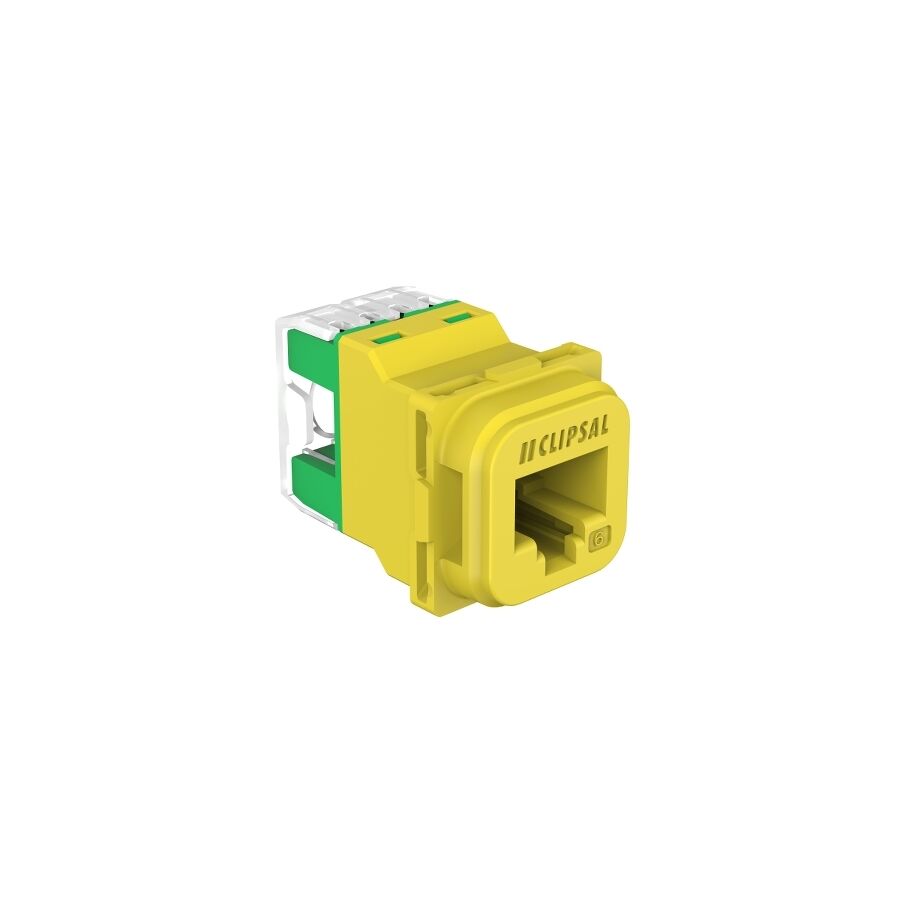
G'day! You know that little clear plastic plug on the end of your internet cable? The one you plug into your NBN box, the back of your computer, or your smart TV? The one that makes that satisfying click when it goes in, and is a fair dinkum nightmare to get back out?
That, mate, is the RJ45 connector. It's the humble, unsung hero of our modern, connected Aussie lives. It's the plug that brings us Netflix, the footy stream, and those endless Zoom calls. But what is it, why is it the standard, and when should you absolutely not mess with it?
So, What is an RJ45, Exactly?
RJ45 (which stands for Registered Jack 45) is the technical name for the standard connector used in computer networking. We're talking Ethernet cables, mate.
Its one and only job is to be the plug on the end of a data cable, allowing you to plug your devices into the network. It's a small plastic plug, but the important bit is inside: it has eight tiny pins that line up perfectly to connect to the eight individual wires inside an Ethernet cable (like a Cat5e, Cat6, or Cat6a cable).
This 8-pin setup is what allows it to handle the massive, high-speed data streams we need for fast NBN, 4K streaming, and online gaming.
The Big Confusion: RJ45 vs. That Old Phone Plug (RJ11)
This is the bit that catches people out. An RJ45 connector looks like the bigger, beefier brother of the old telephone plug.
- RJ45 (The Internet Plug): This is the wide one, with 8 pins. It's for data and networking.
- RJ11 (The Old Phone Plug): This is the skinny little fella, with usually 4 or 6 pins. It's only for old-school landline telephones.
They look similar, but they're not interchangeable. Trying to jam your NBN plug into an old phone socket is a recipe for a bad time.
Why is it the Go-To Connector? (The Ripper Benefits)
The RJ45 connector is the king of networking for a few simple reasons:
- It's Standardised: Every NBN box, modem, router, computer, and smart TV in the world has the same port. It just works.
- It's Reliable: That little plastic 'clicky' tab (the one that always snaps off when you stand on it!) is a positive locking mechanism. It holds the plug securely in the socket, so a dodgy connection won't drop you out in the middle of a gaming session.
- It's Fast: The 8-pin design is what allows it to handle the blazing-fast speeds of modern Ethernet, up to 10 Gigabits per second with the right cable and connector (like Cat6a).
The CRITICAL Safety & Compliance Warning: This is NOT a DIY Job, Mate!
Righto, let's get dead serious for a sec, because this is the most important part of the whole article.
Buying a pre-made Ethernet cable (a 'patch lead') with RJ45 connectors on the end from a shop is a "go for your life" DIY job. Too easy. Even making your own patch cable with a crimping tool is a common DIY task.
But what if you want a new data point in the wall? This involves running a data cable inside your walls and connecting it to a socket (an RJ45 "mech").
In Australia, this is strictly not a DIY job. Any fixed data, communications, or telephone cabling must be installed by a licensed cabler (registered with ACMA).
Why? It's the law, mate. A dodgy data install (especially with cheap parts from a non-specialist supplier) can create interference (messing up your and your neighbour's NBN) or, worse, if it's run too close to 240V power wiring without proper separation, it can become a serious electrical hazard. Don't be a galah.
A Professional Job Needs Professional Gear
A licensed cabler or licensed electrician knows that a rock-solid, high-speed network relies on high-quality, compliant components from end to end. They can't risk their reputation on cheap, dodgy RJ45 connector plugs that will just fail in six months.
This is why they source their gear from a trusted electrical wholesaler. As one of Australia's most comprehensive electrical wholesaler and supplier networks, Schnap Electric Products stocks the lot for the professional installer. They've got a massive range of high-quality, professional-grade data gear, including RJ45 connectors (Cat6, Cat6a), wall mechanisms ('mechs'), data cable, patch panels, and all the specialist crimping and testing tools that a qualified professional needs to do the job right, compliant, and ready for high-speed Aussie internet. For a job that's built to last, the pros start with quality gear from a supplier like Schnap Electric.
RJ45 Cable

G'day! Let's talk about that cable. The one you plug into the back of your NBN box, your smart TV, your gaming console, or your computer. The one that gives you that lightning-fast, rock-solid internet connection when the Wi-Fi is being a bit of a galah and buffering every five minutes.
That, mate, is your RJ45 cable. It's the fair dinkum backbone of a fast and reliable home network, and it's far superior to relying on Wi-Fi for your important gear.
What is an RJ45 Cable, Exactly?
This is where the lingo gets a bit mixed up. We all call the whole thing an RJ45 cable, but technically:
- The RJ45 is the little clear plastic plug (connector) on the end.
- The Cable is the long bit, which is usually a "Category 6" (Cat6) or "Category 5e" (Cat5e) cable.
But let's be honest, everyone in Australia just calls the whole thing an RJ45 cable or an "Ethernet cable," and we all know what we mean. Its one and only job is to carry high-speed digital data from your modem or router straight into your device.
Don't confuse it with your grandad's phone cable! A proper RJ45 cable has a wide plug with 8 tiny pins inside. The old-school telephone plug (an RJ11) is much skinnier and only has 4 or 6 pins. They're not interchangeable.
Why Bother? Isn't Wi-Fi Good Enough?
Wi-Fi is ripper for wandering around the house with your phone or laptop. No doubt about it. But for your high-demand, stationary gear (like your TV, gaming console, or home office PC), Wi-Fi can be a proper nightmare. It can be flaky, slow, and get interference from your neighbour's network or even the bloody microwave!
A hardwired RJ45 cable gives you a direct, stable, physical connection. This means:
- Faster Speeds: You'll almost always get a faster, more consistent speed than on Wi-Fi.
- Lower Latency (Ping): This is the big one for gamers. A wired connection gives you a much lower ping for a lag-free experience.
- Rock-Solid Reliability: No more random dropouts in the middle of a 4K movie or a massive Zoom call.
The Quick Guide: Cat5e vs. Cat6
When you buy an RJ45 cable, you'll see "Cat5e" or "Cat6" on the packet.
- Cat5e: This is the older standard. It's fine for most basic Aussie NBN plans.
- Cat6: This is the new, modern standard. It's a bit thicker, has better internal shielding (to stop interference), and can handle much faster speeds (up to 10 Gigabits over shorter runs). For any new install, you'd be a mug not to use Cat6. It's what any pro would recommend.
The CRITICAL Safety & Compliance Warning: DIY vs. Pro
Righto, this is the most important part, so listen up.
- DIY: Buying a pre-made RJ45 cable (called a "patch lead") from a shop to connect your NBN box to your PC? Go for your life, mate. Too easy.
- PRO ONLY: Want a new data point in your study or media room? This involves running a data cable inside your walls and terminating it at a wall plate.
In Australia, this is strictly not a DIY job. Any fixed data, communications, or telephone cabling must be installed by a licensed cabler (registered with ACMA).
Why? It's the law, mate. A dodgy data install (especially with cheap parts from a non-specialist supplier) can create interference (messing up your and your neighbour's NBN) or, worse, if it's run too close to 240V power, it can become a serious electrical hazard. Don't be a galah.
A Professional Job Needs Professional Gear
A licensed cabler or licensed electrician knows that a rock-solid, high-speed network relies on high-quality, compliant components from end to end. They can't risk a job on cheap, dodgy cable or connectors that will fail in a year. That's why they source their gear from a trusted electrical wholesaler.
As one of Australia's most comprehensive electrical wholesaler and supplier networks, Schnap Electric Products stocks the lot for the professional installer. They've got a massive range of high-quality, professional-grade Cat6 RJ45 cable, connectors ('jacks' and 'plugs'), wall plates, and all the specialist crimping and testing tools that a qualified professional needs to do the job right, compliant, and ready for high-speed Aussie internet. For a connection that won't let you down, the pros start with quality gear from a supplier like Schnap Electric.
RJ45 Crimping Tool
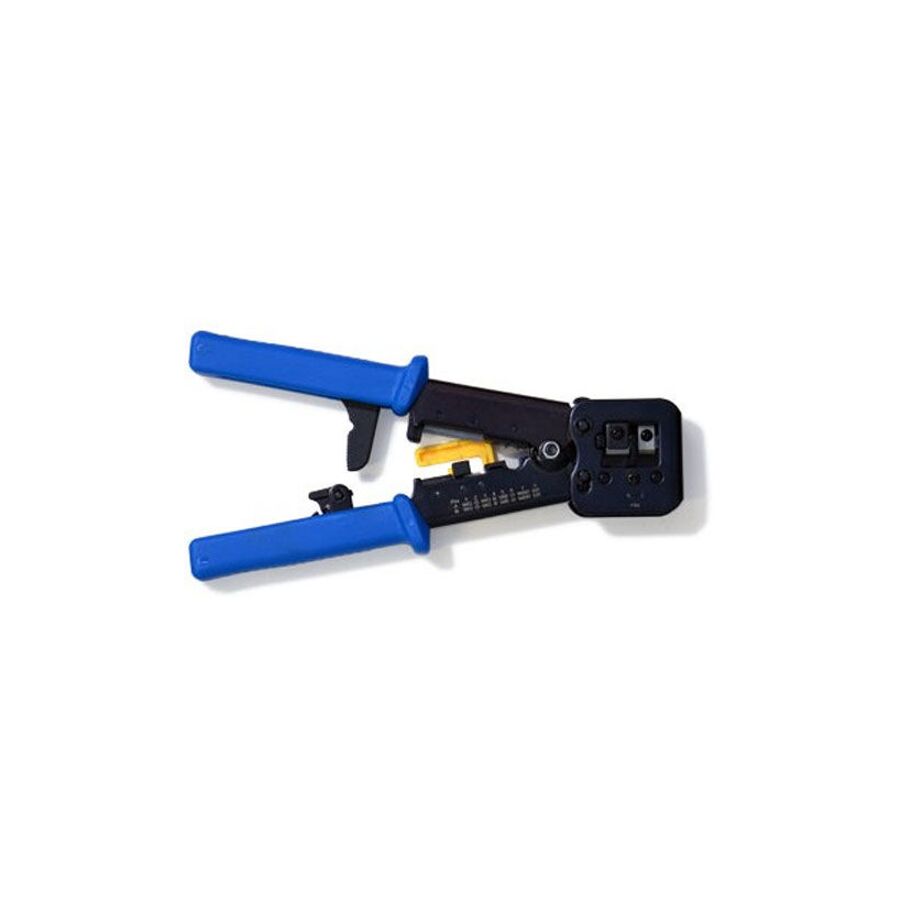
G'day! You're in the middle of a job. You've just run a new Ethernet cable from the NBN box to your home office, and now you're faced with the fiddly bit: putting that little clear plastic plug (the RJ45) on the end.
It's bloody tempting to just try and jam the wires in and squash the plug with a pair of pliers, "she'll be right," yeah?
Wrong, mate. That's a one-way ticket to a dog's breakfast of a connection. It'll be slow, flaky, and will probably stop working the second you look at it funny. To do this job properly, you need the one and only tool for the job: the RJ45 crimping tool.
So, What is an RJ45 Crimping Tool, Exactly?
An RJ45 crimping tool (or 'crimper') is a specialist hand tool that looks a bit like a futuristic pair of pliers. Its one and only job is to perfectly attach an RJ45 plug onto the end of an Ethernet cable (like your Cat6 data cable).
A good one often does three jobs:
- Cuts: It has a sharp blade to cut the cable to length.
- Strips: It has a (sometimes average) stripper to remove the cable's outer jacket. (A separate rotary stripper is often a better bet, but this'll do in a pinch).
- Crimps: This is its main, all-important job.
When you squeeze the handles, it performs two critical actions at the same time: it pushes the eight tiny gold pins down through the insulation to pierce the eight individual wires, and it pushes the plastic strain-relief clip down to grip the cable jacket, so it can't be pulled out.
The Golden Rule: Why You Can't Just "Have a Go" with Pliers
A proper RJ45 crimping tool applies precise, even pressure across all eight pins at the exact same time.
If you try to use pliers, you'll be a one-man wrecking crew. You'll crush the plastic plug, you'll push some pins in too far, others not far enough, and you'll end up with a knackered connection that'll have you tearing your hair out trying to find the fault. You must use the right tool.
The Quick 'How-To' for a Schmick Crimp
Righto, so you're ready to have a crack at making your own patch lead? Here's the quick and dirty:
- Strip the Outer Jacket: Carefully strip about 3cm of the outer (e.g., blue) jacket off the cable, being careful not to nick the little wires inside.
- Untwist and Order: This is the most important bit. Untwist the four pairs of wires. In Australia, the standard we use 99% of the time is T-568B. You need to flatten those wires out and get them in this exact order (from left to right, with the plug's clip facing away from you): White-Orange, Orange, White-Green, Blue, White-Blue, Green, White-Brown, Brown.
- Trim and Shove: Hold the wires flat and in order. Use your crimper's flat blade to cut the ends off perfectly straight, leaving about 1.5cm of wire. Shove them all the way into the RJ45 plug until you see the copper ends hit the front. Make sure the outer jacket is inside the plug, under the strain-relief.
- Crimp it! Shove the plug into the 8P8C (RJ45) slot on your RJ45 crimping tool and give the handle one good, firm squeeze until you hear it ratchet all the way. Pull it out. You beauty! You're done.
The CRITICAL Safety & Compliance Warning: DIY vs. Pro
This is where we get dead serious, mate.
- DIY: Making your own "patch lead" (a cable to go from the wall plate to your computer) is a great DIY job. Go for your life.
- PRO ONLY: Want to install a new data point? This means running a data cable inside your walls, floor, or ceiling and terminating it at a wall plate.
In Australia, this is strictly not a DIY job. Any fixed data, communications, or telephone cabling must be installed by a licensed cabler (registered with ACMA).
Why? It's the law, mate. A dodgy data install (especially with cheap gear from a non-specialist supplier) can create interference (messing up your and your neighbour's NBN) or, worse, if it's run too close to 240V power without proper separation, it can become a serious electrical hazard.
A Professional Job Needs Professional Gear
A licensed cabler or licensed electrician knows that a rock-solid, high-speed network relies on high-quality, compliant components from end to end. They get their gear from a trusted electrical wholesaler. As one of Australia's most comprehensive electrical wholesaler and supplier networks, Schnap Electric Products stocks the lot for the professional installer. They've got a massive range of professional-grade RJ45 crimping tools, data cable testers, and, just as importantly, the high-quality, compliant Cat6 cable, RJ45 plugs, and wall jacks (mechs) that a qualified professional needs to do the job right. For a connection that won't let you down, the pros start with quality gear from a supplier like Schnap Electric.









